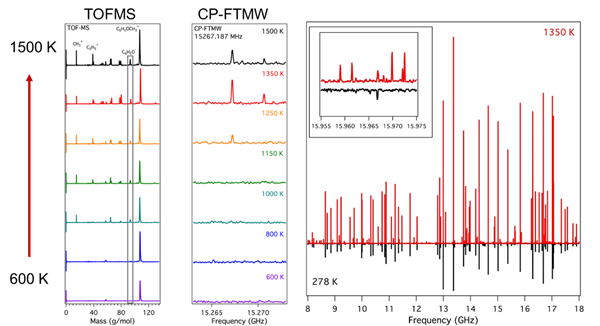Reports: ND655152-ND6: Broadband Microwave Characterization of Pyrolysis Intermediates Formed by Oxygenated Fuels
Timothy S. Zwier, Purdue University
The chemical complexity of hydrocarbon fuels and the fast-expanding list of oxygenated fuels used as additives present a challenge to the scientific community seeking to provide a molecular-scale understanding of their combustion. The development of accurate combustion models stands on a foundation of experimental data on the kinetics and product branching ratios of individual reaction steps. This grant has as its new direction the marriage of a hyperthermal reactor as flash pyrolysis source with broadband microwave detection to carry out isomer-specific spectroscopy on the reactive intermediates formed during their pyrolysis and combustion. Chirped-pulse Fourier Transform microwave spectroscopy (CP-FTMW) is being used to provide high-resolution microwave data spanning the 2-18 GHz range to structurally characterize key fuel components and pyrolysis intermediates.
During the second year of the grant, we have made major improvements to the apparatus that are having a positive impact on our ability to identify and assign spectra of resonance-stabilized radicals formed during pyrolysis of model biofuels. The vacuum chamber used for microwave studies of pyrolysis intermediates incorporates a pulsed valve to which a resistively heated SiC tube is attached for flash pyrolysis (Figure 1, left). We have now added a water-cooled stage to the copper base to shield the pulsed valve from the high temperatures, and improved the robustness of the heating elements so that stable temperatures in excess of 1300oC are now routine. More importantly, we have incorporated a custom-built time-of-flight mass spectrometer immediately after the microwave region (Figure 1, right). Using 3rd harmonic generation of 355 nm light from a pulsed Nd:YAG laser, we now monitor the effluent from the pyrolysis source via VUV single-photon photoionization time-of-flight mass spectroscopy at 118 nm. We are using this gentle and general ionization scheme to determine the molecular formulae of the pyrolysis intermediates and follow their temperature-dependent signals. Comparison with the CP-FTMW spectra produce mass-correlated CP-FTMW spectra that aid in the assignment process.
Figure 1. Schematic diagram of the water-cooled flash pyrolysis source (left), and a picture of the CP-FTMW chamber with the VUV cell and TOFMS sections newly incorporated (right).
Figure 2. (Left) Temperature-dependent series of 118 nm VUV TOF mass spectra of the pyrolysis of anisole as a function of pyrolysis source temperature, compared with CP-FTMW spectra of transitions assigned to the phenoxy radical. (Right) Overview CP-FTMW spectrum of supersonically cooled anisole at 298 K, and after flash pyrolysis at 1350 K. The inset shows phenoxy radical transitions in a small region of the spectrum.
To illustrate, we present in Figure 2 preliminary results on flash pyrolysis of anisole (C6H5-OCH3), leading to formation of phenoxy radical and methyl radical as primary thermal decomposition products,
C6H5-OCH3 → C6H5O (phenoxy) + CH3.
To date, we have obtained and assigned CP-FTMW spectra of the phenoxy radical, the ortho-hydroxy phenoxy radical from thermal decomposition of guaiacol, and the 2-furanyloxy radical from pyrolysis of 2-methoxy-furan. During the coming months, we will finish the analysis of these free radical spectra and prepare manuscripts describing that work. We will also expand our studies of lignin-related pyrolysis to syringol, another of the model compounds present in liginin.
Alicia Hernandez-Castillo has been supported on a graduate research assistantship by this grant. She is currently in her fourth year of graduate school. During the period of her support from PRF, she has gained extensive experience in broadband microwave spectroscopy, data analysis, and laser-based mass spectrometry. She has developed a suite of MatLab programs that she uses to process and analyze the broadband microwave data.
As principal investigator, this New Directions grant has provided critical resources to develop microwave-based methods for detecting single components of mixtures and expand our capabilities to include the multiplexed detection schemes combining CP-FTMW and VUV TOFMS of pyrolysis intermediates.














